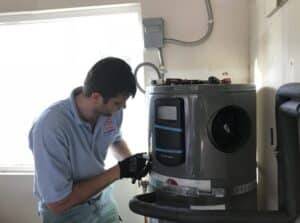
It is important to ask what temperature should your water heater be set at. The temperature of the hot water heater should be chosen so that it combines safety and energy efficiency. Typically, a temperature of between 49°C and 60°C (or 120°F and 140°F) is advised.
While temperatures beyond 140°F can raise the risk of scorching and also result in energy waste, temperatures below 120°F might not be hot enough for regular use. The growth of bacteria in the water tank can also be aided by greater temperatures, it is crucial to remember.
Thus, it is advised to adhere to local building requirements and manufacturer instructions to ensure the hot water heater operates safely and effectively.
If you are concerned that the temperature of your water heater is set incorrectly, call a plumber who can quickly verify the setting with a special thermometer and make the necessary adjustments.
A specialist will be able to examine the hot water tank for sediment build-up and calcification if you have tried increasing the temperature of the water tank but have not observed any change in the temperature. If you hear hissing or sizzling sounds, that may also mean sediment has accumulated in the tank.
A specialist can drain the tank, remove any built-up scale, and then soak the components to resolve the issue.
The water heater’s temperature dial should be marked with a permanent marker once you’ve reached the desired temperature.

If the temperature on your water heater is 140 degrees, it could be worthwhile to try a lower setting. Here are a few causes for this:
The risk of scorching is lower for most adults. We have an innate understanding that we should check the water’s temperature in the shower or tub before entering.
Scalding, however, presents a significantly greater risk to small children, old people, and babies. Scalding poses a major risk to young children, especially those under the age of 3. Youngsters frequently lack the knowledge to check the temperature of the water before jumping in.
The ability of older persons to perceive temperature at a distance may be limited by situations. You should lower the water temperature if you have kids or elderly people living in your house for their occupational safety.
You’ll save more money if you lower your water heater by one degree at a time. Energy is required to heat water and keep it warm over time. Your monthly utility cost will be reduced the lower the temperature your water heater is set to.
If you want to save money in your home, try lowering the water heater’s temperature a little to see if you even feel the change.
Even small savings can pile up over time because the average American home’s water heater contributes for 20% of the entire electricity cost.
Your home will actually have more hot water to use on busy mornings if your water heater is set at a higher temperature. This is due to the fact that hot water is blended with cold tap water before it arrives at the faucet. The supply can be stretched longer by the hotter hot water since less of it is required to mix with the cold water.
Small families of two to three people, though, probably won’t be impacted by this. Probably a better choice would be to lower the temperature and spend less money.
You can see that the response to the query “Is my water heater too hot?” is frequently “It depends.” We advise speaking with one of our skilled plumbers if you have any concerns regarding the temperature setting on your water heater. They can offer you specialized advice while taking into account your home.
Are people truly in need of instructions on how to turn a knob? I imagine some readers of this are a little perplexed at this point.
You’re right; it’s rather simple if your water heater has a temperature knob or digital temperature controls you may use to directly set its temperature.
Turn off the water heater’s power or, in the case of a natural gas system, the gas whenever you’re opening it up or performing maintenance on it. Make sure there is no electricity to the system before continuing with this step for your electric water heater at the circuit breaker.
You must turn off the electricity before performing any repair, including draining and cleansing your water heater or changing the heating element.
All save one panel, which is secured to the tank body by 2-4 screws, are smooth on the water heater tank. Take care not to loose them while you remove these screws with a screwdriver. next carefully remove any insulation that is obstructing your view of the temperature controls concealed behind this panel.
You don’t want to remove the insulation surrounding your water heater or bend it so far that it tears because this insulation keeps the appliance functioning efficiently. Peeling it should be possible, and you can hold it out of the way as you carry out the following action.
Most thermostats for water heaters are small and simple to overlook. Look for a dial that has temperature marks around it that is metal or plastic.
Make a note of the temperature that your water heater is now set at (as we mentioned, most manufacturers program your water heater set at 140 degrees, right out of the box) and use a flathead screwdriver to adjust the dial and the temperature as necessary.
It really is that easy. Your system will begin heating water to the desired temperature as soon as you’ve finished the following step and put your gas or electric water heater back together.
Once you’ve properly adjusted the water heater’s temperature, put the insulation you previously pulled back in place before screwing the access panel lid back on. Now that the machine is powered again, you can. If you have a gas water heater, you might need to relight the pilot light to get the appliance to function properly.
Remember that the type of pipe, the method of heating the water (gas or electric), and whether your system is a tank or tankless have no influence on the temperature, no matter what setting you select. Nonetheless, there are a few factors to take into account while choosing a temperature:
The average energy use of a home is made up of 14–18% by the water heater. It could also be tempting to reduce the temperature to save money.
It’s important to remember that decreasing the temperature by 10°F results in a 3-5 percent energy savings. The opposite is true for legionella, which can survive at high temperatures as high as 122°F. In order to achieve your energy consumption goals, balance your risk tolerance!
Play around with it if you’re still unsure. On hot water heaters, a temperature dial is usually present. If yours doesn’t, let the water flow for a while and check the temperature using a thermometer. Start at 120 degree Fahrenheit and raise it to the desired temperature over time.
In conclusion, it might not be as easy to set the right temperature in your home and forget about it. In homes where maintaining a higher hot water temperature for health adminsitration & safety must be balanced with the risk of scorching, a water tank booster may be the answer.
In order to prevent bacteria, it maintains your tank at 140°F while blending cold water to provide a lower temperature at the tap.
Your water heater’s temperature setting may surely have an impact on your home’s energy bill. The water heater accounts for 17 to more than 25% of your monthly energy costs, is one of the most energy costs for a home.
The Department of Energy claims that lowering the temperature of your water heater will considerably lower standby losses, or the price of heat lost from the water heater into the vicinity of it.
You can lose between $36 and $61 in standby heat each year if your water heater is set at 140 degrees or a few degrees higher. Washing your dishes, clothes, and taking a bath at a lower temperature will help you save even more money. These savings might total more than $400 annually, according to the Energy Department’s assessment.
Most hot water heaters should last between 8 and 12 years, according to predictions. You should think about replacing your water heater if it is 10 years old or older and appears to be leaking or not functioning correctly rather than making a repair that will only solve the issue momentarily.
It’s easy to change your water heater’s temperature setting, as we’ve explained in the sections above. Nonetheless, you should contact a plumbing expert for assistance if you ever run into trouble or get stuck when working on your water heater.
Water heater manufacturers do keep an owner’s manual on them you can follow to adjust the water heater temperature setting on your water heater. However, if you feel uncomfortable doing this by yourself, it is always best to call a professional.
Most experts agree that a hot water heater functions most efficiently between 120 and 140 degrees Fahrenheit.
Most experts agree that a hot water heater functions most efficiently between 120 and 140 degrees Fahrenheit.
The ideal temperature of the hot water that is delivered to your faucets and appliances depends on how your hot water heater is set up. It’s possible that some applications won’t benefit from a temperature that is set too low. It could burn skin if it’s set too high or use more energy.
Although a hot water heater’s temperature can be increased, doing so is not advised. Water that is over 140 degrees can scorch people and result to scald burns.
With the aid of a thermometer, you can gauge the temperature of your water heater by observing the temperature of water from a water tap.
Mike Joshua, a 33-year-old plumber based in California. With a passion for solving complex problems and a commitment to his trade, Mike has dedicated the past 8 years of his life to honing his skills as a professional plumber. After completing technical college Mike quickly secured a job in a plumbing company and has been working steadily ever since. Mike's experience includes not only households but industrial gas and plumbing systems and installation, repair the equipment for different types of business He is known for his attention to detail, strong work ethic, and ability to complete projects on time and within budget. He is always striving to improve his skills and stay up-to-date with the latest industry developments and advancements. In conclusion, Mike enjoys outdoor activities such as hiking and camping. He also has a passion for DIY projects around the home and is always looking for new challenges to tackle.

